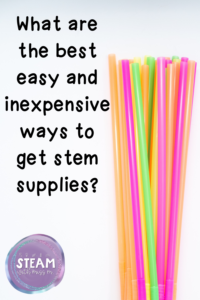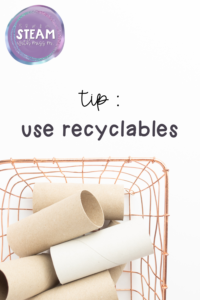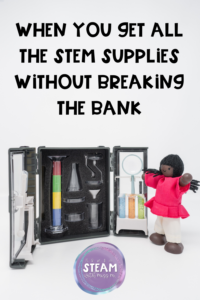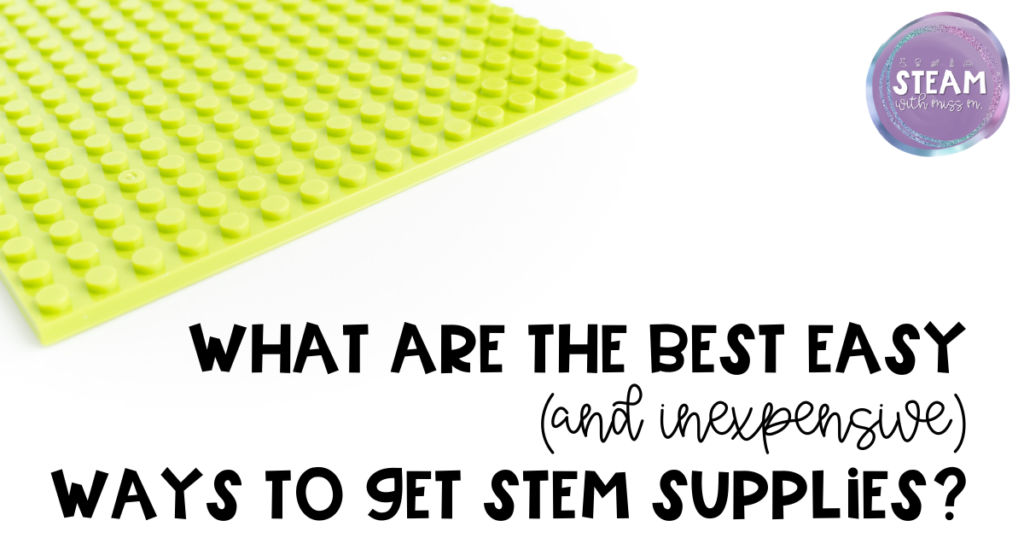Getting supplies is probably one of the hardest things when it comes to doing STEAM or STEM in your class. We already spend way too much on our classroom, so it’s hard to justify buying all those supplies. And if you have multiple classes and 100 (or even more!) students, it really adds up quickly. It can definitely be a barrier that keeps you from doing these kinds of activities in your classroom. But the good news is that there are ways to get materials without breaking the bank. It doesn’t have to keep you from doing all the STEM activities you want to do. Here are some ways I’ve learned some ways to keep the costs minimal while stocking your STEM cupboard. Read on for what I’ve found to be the best and inexpensive ways to get stem supplies.

Dollar Tree is your best friend
They have so much stuff you can use for so many different projects. You can shop at any dollar store to save money, but Dollar Tree is my personal favorite because everything is only $1 ( …. well, for now). It’s a great place to get all those consumable supplies for super cheap. Think things like baking soda, vinegar, foil, …. those sorts of supplies. Stock up on plastic table cloths while you’re there. (Trust me, you’ll thank me when you don’t have to scrub paint or dried up oobleck or something off your desks or floor.) They have all kinds of fun props for your builds (your seasonal steam challenges just became a lot more fun) or classroom transformations if you’re into that sort of thing. They also have knock off building bricks and mini figures, even baseplates, which is a game changer.
Use recyclables
Not only are you not spending any money on new supplies, but you’re recycling and helping the environment. Win-win! There’s so many things you can do with these materials that would otherwise end up in the trash. Plastic bottles can be used for bottle rockets (add some baking soda and vinegar, or water and alka seltzer), water filters (check out how here), or sensory jars.
Cardboard boxes are probably my all time favorite building material. The only limit to what you can do with them is your imagination. One of my students’ favorite projects was making haunted houses from them to celebrate Halloween (aka the best holiday). Box Wars is also a lot of fun (it’s a perennial summer camp favorite for us at my office). Students design and create armor and weapons out of cardboard boxes and then have a big mock battle. And we’ve all been ordering way too much stuff online since this pandemic started, so you know there’s certainly plenty of boxes lying around just waiting to be reused.
Everybody has tons of junk mail, so put that paper to good use. You can have students build a bridge or make paper chains.
Do you have a ton of old CDs for ancient computer programs you no longer use (because they don’t work with today’s computers) taking up space in a random closet in your school? They make great wheels for cars.
Put your thinking cap on. Get creative. Clean trash items like these make excellent materials for a wide variety of stem and steam projects.

Get donations
You don’t have to do it alone. Ask for cardboard boxes or magazines (or any other supply you want to use) in your next newsletter to parents. I’m sure some of them have some of those things lying around their house and they would be happy to help you out and get rid of it. Ok, this does require you to plan in advance so that you can ask well before you need the supplies. You could keep a running list of your most used supplies to help. Sometimes your school board or PTA can help out with some donations or funds. There are also a ton of grants out there. A little Google search and some writing could really pay off. If you do end up having to buy supplies, explain that you’re a teacher and a little bit about what project you’re doing with your class and ask if they can donate anything. Many places will be happy to help out a local teacher and they may even have a stash of materials ready to donate. You might get your supplies, or at least some of them, for free. You don’t have anything to lose, so you should definitely ask. Worst case scenario is that the store says “sorry, can’t help you” and you pay for those supplies yourself, which is what you planned to do anyway. But if you don’t ask, you’ll never know.
Find reusable supplies
Things like building bricks and wooden planks may be an investment at first, but the kids will use them countless times and they will last you for years. If you can buy things that can be used over and over again, then do it! Or, see if parents are getting rid of any sets their kids don’t play with any more. (The museum I worked at received ridiculous amounts of donations when we created a bricks exhibit. So many of them!) You can sometimes score at yard sales too. When you do purchase something for your class, think of ways it could be used again. That lamp for your reading corner could double as extra lighting for filming green screen videos. Easter eggs can be reused for an egg drop challenge. Things with multiple purposes that you can use again and again will cut down on the amount you spend to stock your supply closet (and eliminate waste).
Make it a demo
Want to do an experiment or project that involves more expensive supplies? Make it a demo. Either just the teacher can do it, or they can split into a few groups. This is a great way to do those big, crazy projects (like elephant toothpaste) or projects that require expensive or hard to get reagents without breaking the bank. Since you’re doing it fewer times than if every student does it individually, you won’t need to buy nearly as much.
Virtual options
Ok, ok, I know. I know we’re all completely sick of virtual by this point, but hear me out. There are tons of great online demos and simulations out there. Many are free even. Who doesn’t love free? They’re a great tool to use in your class. They help students visualize the concepts we’re teaching, and let’s face it they are way more engaging than listening to their teacher drone on. Sure, you could buy a bunch of hotwheels and tracks and let the kids play around to learn more about forces and motion and energy, but have you done PHET’s skate park simulation? Not only is it amazing, but it’s so much fun (even for me as an adult). I definitely wouldn’t rely entirely on these virtual labs or demos, but if you aren’t able to get the supplies (say if you’re teaching about radioactivity and carbon dating) or it’s too expensive, there’s nothing wrong with using this alternative sometimes.
And there are so many amazing educators or experts in stem fields putting out videos on youtube or tiktok. Maybe it isn’t feasible to give all 100 some odd students all the reagents or supplies for whatever you’re planning, but it is completely doable to show them a video.
Bonus points, use the video to help students practice observation and communication skills that are so important to stem. Ask them questions like what are they seeing, why do they think it’s happening, how would doing x change things, etc.

I hope these ideas are useful to you. Do you have other suggestions for getting stem supplies on the cheap? Where’s your must shop store when stocking up? I’d love to hear them!


